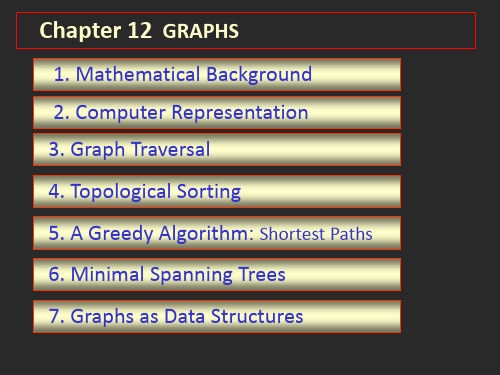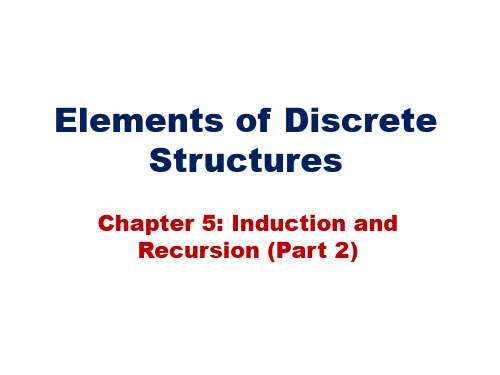- 1、下载文档前请自行甄别文档内容的完整性,平台不提供额外的编辑、内容补充、找答案等附加服务。
- 2、"仅部分预览"的文档,不可在线预览部分如存在完整性等问题,可反馈申请退款(可完整预览的文档不适用该条件!)。
- 3、如文档侵犯您的权益,请联系客服反馈,我们会尽快为您处理(人工客服工作时间:9:00-18:30)。
A D C A D
C
B
B
Graph and Diagram
Graph G is a triple: G =〈VG, EG, 〉
VG and EG are sets,satisgying VGEG=φ, :EG {{vi, vj}| vi, vj∈VG} Note: {vi, vj}={vj, vi} A graph can be represented conveniently by some diagram: : each element of VG as a dot, the vertex, and each element of EG as a line segment, the edge, between vertices. So, VG is called the set of vertices, and EG, the set of edges.
i i =1
The number of vertices with odd degree must be even.
Complete Graph
A graph is a complete graph if and only if any two of its vertices are adjacent.
Subgraph
Let G=<V,E>, G’=<V’,E’>, if V’V, E’E, then G’is called a subgraph of G. If V’V, or E’E, then G’ is a proper subgraph. If V’=V, then G’ is a spanning subgraph.
Determination of Euler Graph
Three equivalent statements for a nontrivial connected graph G:
(1) G is an Euler graph. (2) For any vertex v in G, d(v) is even. (3) All the edges in G constitute one or more simple circuits without common edges between them. Proof: (1)(2): Assuming that W is an Euler circuit in G, then v∈VG, d(v) is 2 times of the number by which v appears on W.
Complete Graph Kn(n=1,2,3,4,5)
K1
K2
K3
K4
K5
A graph G and its complement graph have the same set of vertex, and their edges set constitute a partition of the edge set of the complete graph with the same vertex set.
Abstraction of the problem
Land plots: vertices Being connected by a bridge: edge
A D C A D
C
B
B
Euler Path and Euler Circuit
An Euler path in G is a path which passes each edge in G exactly once. An Euler circuit in G is a circuit which passes each edge in G exactly once. An Euler graph is a graph which contains a Euler circuit. A Semi-Euler graph is a graph which contains a Euler path, but not a Euler circuit.
Path
Definition: ( v0,vk)-path in a graph G is a nonempty sequence: v0e1v1e2v2…vk-1ekvk, among which vi∈VG, ei∈EG, and the two endpoints of ei are vi-1 and vi,(i=1,2,…,k)。 Simple path: v0e1v1e2v2…vk-1ekvk,satisfying i,j, i≠j vi≠vj
Graphs
Lecture 9 Discrete Mathematical Structures
A C D
B
Problem of “Crossing River”
Problem: A person(P), a wolf(W), a lamb(L) and a cabbage(C) will cross a river by a boat which can carry any two of them once. Wolf and lamb, or, lamb and cabbage, cannot stay together without the person present. Remember that only the person can run the boat.
Examples:
Path: uavfyfvgyhwbv Path: wcxdyhwbvgy Simple path: xcwhyeuav Circuit: ueyhwbvau
y d
e
a f g h c v b
x
w
Connected Graph and Components
Graph G is connected if and only if u,v∈VG, there is a uv-path in G. The various connected pieces are called the Components of the disconnected graph If there is only one component in G, then G is a connected Graph.
Solution to the “Crossing River”
Note: There are 16 combinations of (P,W,L,C), but only 10 status are possible.
PWLC PWC PWL PLC PL
WC
W
C
L
φ Success
Seven Bridges at Knigsberg
Numerical characteristics of the degree of vertex
Sum of degree of all vertices in a graph is even.
n
∑ d ( v ) = 2 m m is the number of edges in the graph.
Seven Bridges at Knigsberg
Abstraction
Vertices representing objects - areas Edges representing the relationship between objects – connected by a bridge
Regular Graph
Two typical regular graph:
000 010 011 001
110 100
111 101
Note: in the graph on the left, each vertex is a binary number with the same number of bits.
Simple graph
A graph without ring and multiple edges is called a simple graph.
Degree of Vertex
Degree of vertex
dG(v) = number of edge incident to v
dG(v) must be a nonnegative integer.
Quotient graph
Given (V, E, f), given equivalent relation R :V->V Graph (VR,E’, f’):
f’(e) = ([u],[v]), if there exist s ∈[u], t ∈[v], f(e) =(s,t)
Problem of “Crossing River”
Simple Graph
Multiple edges and ring
If is not a injection, that is, exist ei, ej∈EG, ei≠ej, but (ei)=(ej), then ei, ej 是are called multiple edges.。 For any ei∈EG, if (ei)={vi, vi}={vi}, then ei is called a ring.
Circuit (Cycle)
Circuit is a path of which the starting point and the ending point are identical.
v0e1v1e2v2…vk-1ekvk,satisfying vi=vj
Note: in a simple graph, the denotation of a path can be simplified as v0v1v2…vk-1vk, u





